Mold inspection is crucial for identifying hidden growth that can pose significant health risks, particularly for those with respiratory issues or weakened immune systems. Through a combination of visual inspections, moisture assessments, and air quality tests, professionals can detect mold presence and evaluate potential hazards. Effective remediation strategies are then recommended to eliminate mold and prevent its recurrence, ensuring a safe living environment.
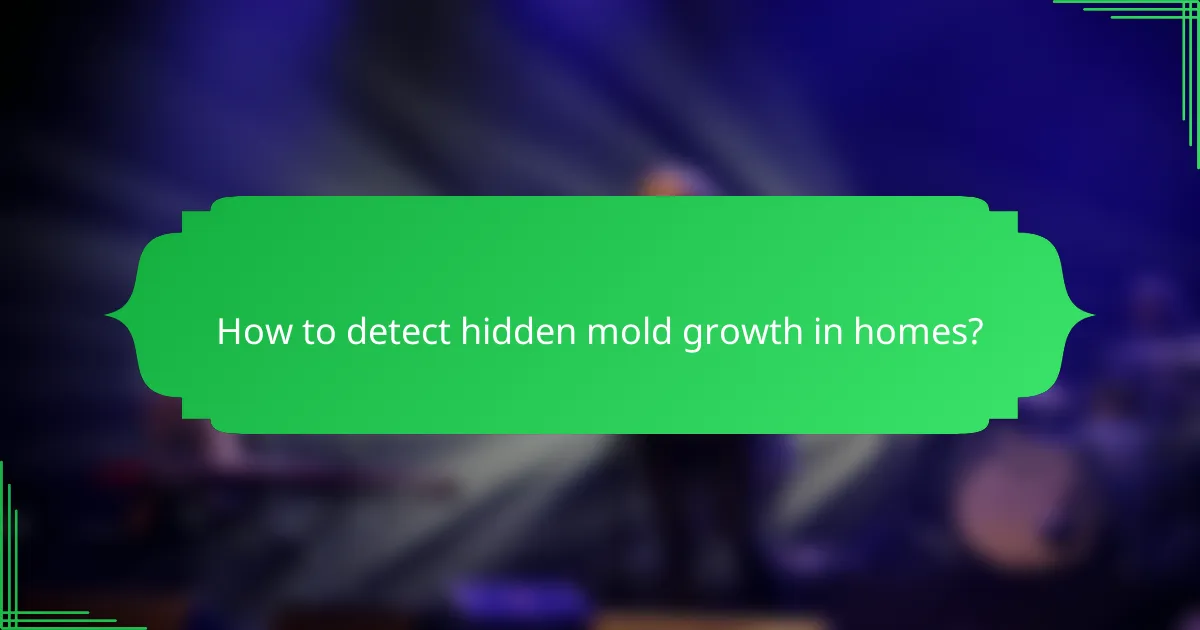
How to detect hidden mold growth in homes?
Detecting hidden mold growth in homes involves a combination of visual inspections, moisture assessments, and air quality tests. These methods help identify mold presence and assess potential health risks associated with mold exposure.
Visual inspection techniques
Visual inspections are the first step in detecting hidden mold. Look for signs of water damage, discoloration, or musty odors, particularly in areas prone to moisture, such as basements, bathrooms, and around windows. Pay attention to hidden spaces like behind drywall or under carpets.
Use a flashlight to inspect dark corners and crevices. Mold often appears as black, green, or white spots, but it can also be hidden behind surfaces. If you suspect mold but cannot see it, further investigation is necessary.
Moisture meter usage
Moisture meters are essential tools for detecting hidden mold growth. These devices measure the moisture content in building materials, helping to identify areas that may be conducive to mold development. A reading above 20% moisture content typically indicates a risk for mold growth.
When using a moisture meter, check various surfaces, including walls, ceilings, and floors. High moisture levels can signal leaks or poor ventilation, which should be addressed to prevent mold proliferation.
Air quality testing
Air quality testing can reveal the presence of mold spores in the indoor environment. This process involves collecting air samples and analyzing them for mold species and concentrations. Elevated levels of mold spores can indicate hidden growth, even if it is not visible.
Consider hiring a professional for air quality testing, especially if you or your family members experience health issues related to mold exposure. Testing can provide a clearer picture of the indoor air quality and guide remediation efforts.
Professional mold inspection services
Hiring professional mold inspection services is often the most effective way to detect hidden mold. These experts use advanced techniques and equipment, including thermal imaging and air sampling, to identify mold growth that may not be visible to the naked eye.
Professional inspections typically include a thorough assessment of the property, moisture readings, and recommendations for remediation. While the cost can vary, investing in a professional service can save money in the long run by addressing mold issues before they escalate.
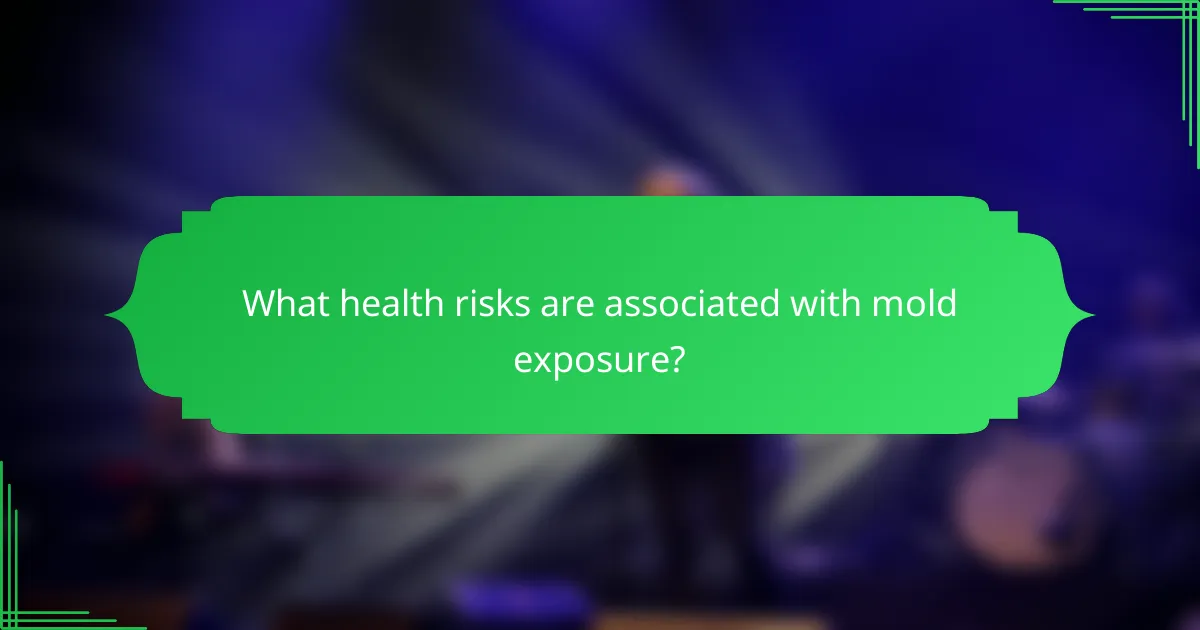
What health risks are associated with mold exposure?
Mold exposure can lead to various health risks, particularly affecting the respiratory system and triggering allergic reactions. Individuals with existing health conditions or weakened immune systems may face more severe consequences from mold exposure.
Respiratory issues
Mold can cause significant respiratory problems, especially in individuals with asthma or chronic lung conditions. Common symptoms include coughing, wheezing, and shortness of breath, which can worsen with prolonged exposure.
In some cases, mold exposure may lead to the development of conditions like hypersensitivity pneumonitis, where the lungs become inflamed due to an immune response. It’s crucial to address mold growth promptly to minimize these risks.
Allergic reactions
Exposure to mold can trigger allergic reactions in sensitive individuals, resulting in symptoms such as sneezing, runny or stuffy nose, and itchy eyes. These reactions can vary in severity, depending on the person’s sensitivity and the amount of mold present.
For those with mold allergies, avoiding damp environments and ensuring proper ventilation can help reduce exposure and alleviate symptoms. Regular cleaning and maintenance can also prevent mold growth in homes and workplaces.
Long-term health effects
Long-term exposure to mold may lead to chronic health issues, including persistent respiratory problems and increased susceptibility to infections. Some studies suggest a potential link between mold exposure and the development of conditions like asthma in children.
To mitigate these risks, it’s essential to conduct regular mold inspections and remediation in areas prone to moisture. Implementing preventive measures, such as using dehumidifiers and ensuring proper drainage, can significantly reduce the likelihood of mold growth and its associated health risks.

What are effective mold remediation methods?
Effective mold remediation methods focus on removing mold growth and preventing its return. These methods can range from simple DIY techniques to comprehensive professional services, depending on the extent of the infestation and the environment.
DIY remediation techniques
DIY remediation techniques can be effective for small mold issues. Common methods include using a mixture of water and vinegar or a bleach solution to clean affected surfaces. Always wear protective gear, such as gloves and masks, to avoid health risks during the process.
Before starting, ensure proper ventilation in the area. For porous materials like drywall or carpet, replacement may be necessary if they are heavily contaminated. Regularly inspect areas prone to moisture, such as bathrooms and basements, to catch mold early.
Professional remediation services
Professional remediation services are recommended for larger infestations or when mold is hidden behind walls or in HVAC systems. These services typically involve a thorough inspection, containment of the affected area, and specialized equipment for removal.
Professionals often use advanced techniques such as HEPA vacuuming and air scrubbing to ensure complete mold removal. While costs can vary, investing in professional services can prevent future health issues and structural damage, making it a worthwhile consideration.
Use of antimicrobial agents
Antimicrobial agents can be used during the remediation process to inhibit mold growth. These agents, which can be applied as sprays or coatings, help to kill mold spores and prevent their return on treated surfaces.
When selecting antimicrobial products, look for those that are EPA-approved and safe for indoor use. Always follow the manufacturer’s instructions for application and safety precautions. Combining these agents with proper ventilation and moisture control can significantly enhance the effectiveness of mold remediation efforts.
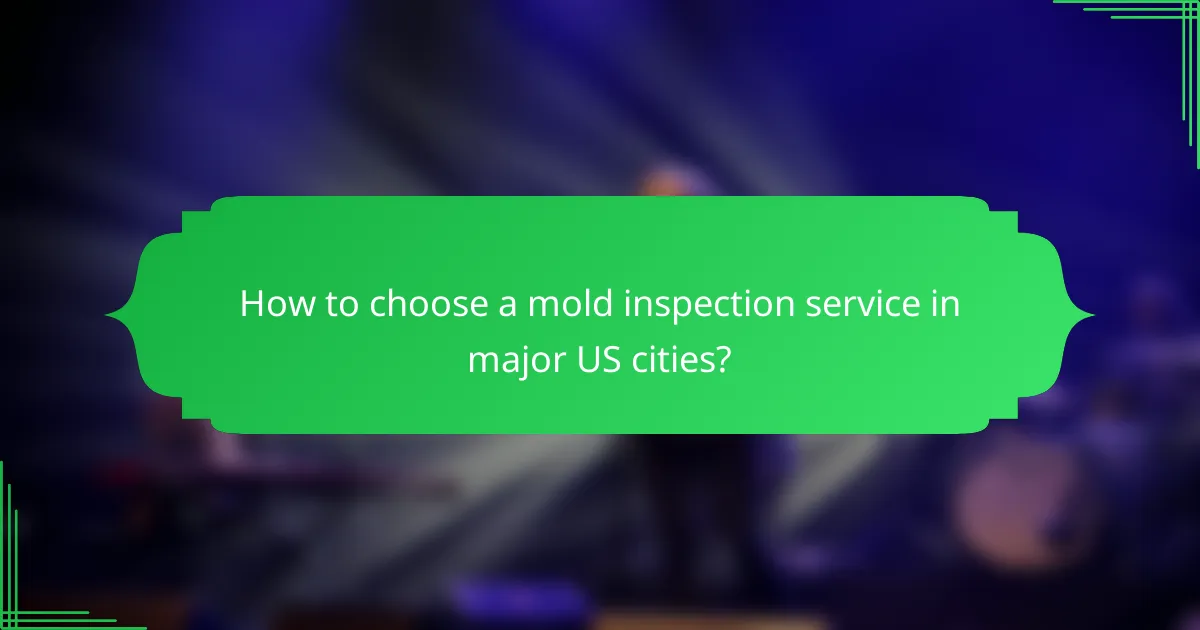
How to choose a mold inspection service in major US cities?
Choosing a mold inspection service in major US cities involves evaluating their qualifications, customer feedback, and service guarantees. Prioritize companies with proven expertise and positive reviews to ensure effective detection and remediation of mold issues.
Certification and qualifications
When selecting a mold inspection service, check for certifications such as those from the Institute of Inspection, Cleaning and Restoration Certification (IICRC) or the National Organization of Remediators and Mold Inspectors (NORMI). These credentials indicate that the inspectors have undergone rigorous training and adhere to industry standards.
Additionally, consider the experience level of the inspectors. Companies with several years in the field are more likely to have encountered a variety of mold situations and can provide more reliable assessments.
Customer reviews and testimonials
Customer reviews and testimonials are crucial in assessing the quality of a mold inspection service. Look for feedback on platforms like Google, Yelp, or Angie’s List to gauge overall satisfaction and service reliability. Pay attention to comments regarding thoroughness, professionalism, and responsiveness.
It can be helpful to ask for references from the company directly. Speaking with past clients can provide insights into their experiences and the effectiveness of the mold inspection and remediation process.
Service guarantees and warranties
Service guarantees and warranties can provide peace of mind when choosing a mold inspection service. Look for companies that offer a satisfaction guarantee or a warranty on their work, which indicates confidence in their services and commitment to customer satisfaction.
Understand the terms of any guarantees offered. Some companies may cover re-inspections or additional treatments if mold returns within a specified timeframe, which can save you money and hassle in the long run.
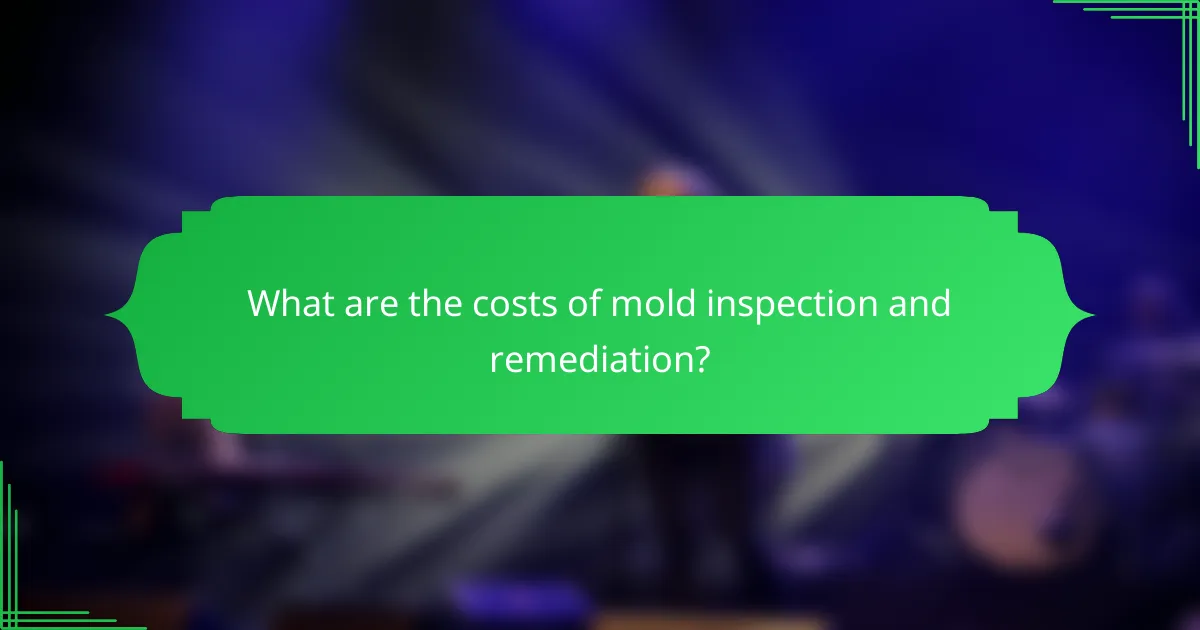
What are the costs of mold inspection and remediation?
The costs of mold inspection and remediation can vary significantly based on several factors, including the size of the affected area and the extent of the mold growth. Generally, homeowners can expect to pay anywhere from a few hundred to several thousand dollars for these services.
Average inspection costs
The average cost for a mold inspection typically ranges from $200 to $600. Factors influencing this price include the size of the property and the complexity of the inspection process. Some inspectors may charge additional fees for air quality testing or specialized assessments.
For larger homes or commercial properties, inspection costs can increase, sometimes exceeding $1,000. It’s advisable to obtain multiple quotes to ensure a fair price.
Remediation pricing factors
Remediation costs can vary widely, generally falling between $500 and $6,000, depending on the severity of the mold issue. Key factors include the extent of the mold growth, the materials affected, and the necessary repairs. For instance, removing mold from drywall may be less expensive than addressing mold in structural beams.
Additional costs may arise from necessary repairs or replacements, such as replacing insulation or flooring. Homeowners should also consider potential costs for follow-up inspections to ensure the mold has been effectively removed.
Insurance coverage options
Many homeowners’ insurance policies may cover mold remediation, but this often depends on the cause of the mold growth. For example, mold resulting from a sudden water leak may be covered, while mold from long-term neglect typically is not.
It’s crucial to review your policy and consult with your insurance agent to understand your coverage limits and any exclusions. Some policies may have specific caps on mold-related claims, so being informed can help you avoid unexpected expenses.
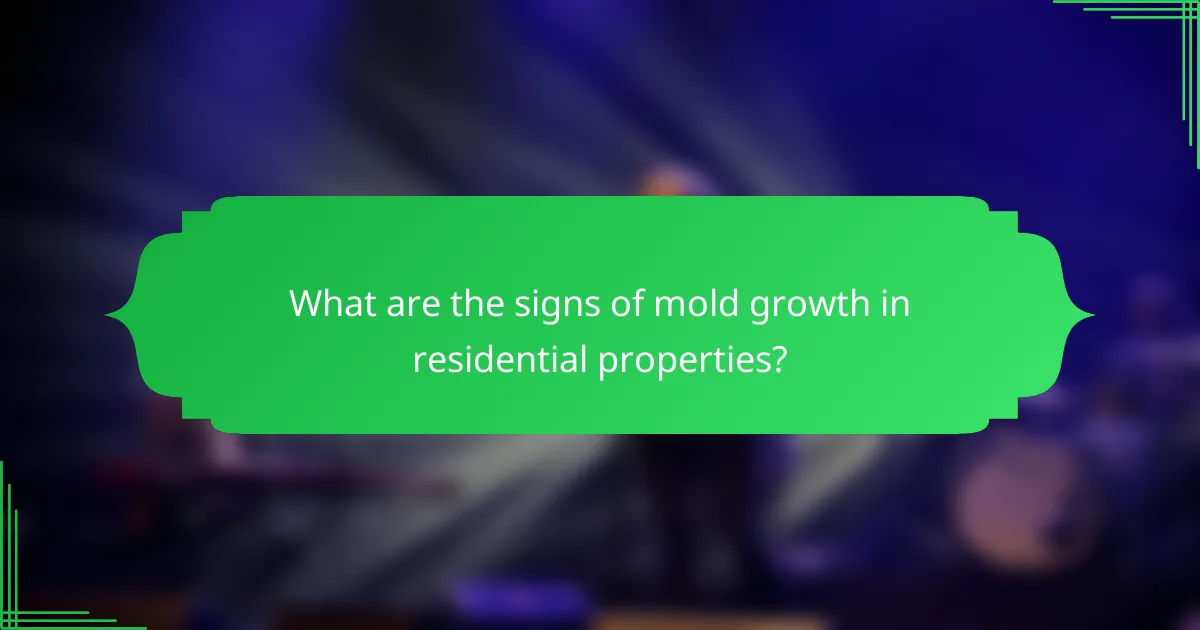
What are the signs of mold growth in residential properties?
Signs of mold growth in residential properties include visible patches and musty odors. Recognizing these indicators early can help prevent health risks and extensive damage to your home.
Visible mold patches
Visible mold patches are often the most obvious sign of mold growth. These patches can appear in various colors, including black, green, or white, and may be found on walls, ceilings, or around windows and doors. If you notice any discoloration or fuzzy growth, it’s essential to investigate further.
Check areas with high moisture levels, such as bathrooms, kitchens, and basements, as these are prime locations for mold. If the patches are extensive or recurring, consider consulting a professional for a thorough inspection and remediation plan.
Musty odors
Musty odors are another common sign of mold presence in a home. If you detect a persistent, earthy smell, it may indicate hidden mold growth, even if it’s not visible. This odor often suggests that mold is thriving in damp or poorly ventilated areas.
To address musty odors, inspect areas like attics, crawl spaces, and behind appliances. Improving ventilation and reducing humidity can help mitigate these smells, but if the odor persists, a professional assessment may be necessary to locate and eliminate the source of the mold.
